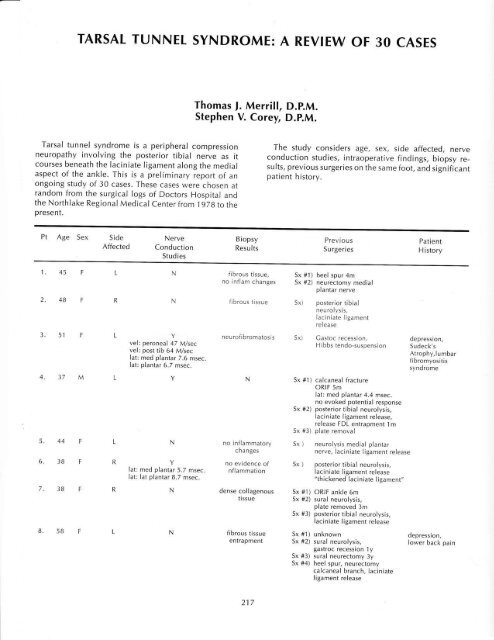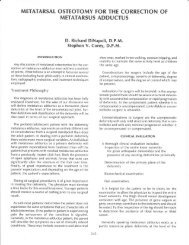TARSAL TUNNEL SYNDROME - The Podiatry Institute
TARSAL TUNNEL SYNDROME - The Podiatry Institute
TARSAL TUNNEL SYNDROME - The Podiatry Institute
You also want an ePaper? Increase the reach of your titles
YUMPU automatically turns print PDFs into web optimized ePapers that Google loves.
<strong>TARSAL</strong> <strong>TUNNEL</strong> <strong>SYNDROME</strong>: A REVIEW oF 30 CASESThomas f. Merrill, D.P.M.Stephen V. Corey, D.P.M.Tarsal tunnel syndrome is a peripheral compressionneuropathy involving the posterior tibial nerve as itcourses beneath the laciniate ligament along the medialaspect of the ankle. This is a preliminary report of anongoing study of 30 cases. <strong>The</strong>se cases were chosen atrandom from the surgical logs of Doctors Hospital andthe Northlake Regional Medical Center from 1978 to thepresent.<strong>The</strong> study considers age, sex, side affected, nerveconduction studies, intraoperative findings, biopsy results,previous surgeries on the same foot, and significantpatient h istory.Pt Age SexS ideAffectedNerveConductionStud iesB iopsyResu ltsPreviousSu rgeriesPatientH istory'1.45483. 514.Yvel: peroneal 47 M/secvel: post tib 64 M/seclat: med plantar 7.6 msec.Iat: plantar 6.7 msec.Yfibrous tissue,no inflam changesfibrous tissueneu rof ibromatosisSx #1 ) heel spur 4mSx #2) neurectomy medialplantar nerveSx)Sx)posterior tibialneu rolysis,laciniate IigamentreleaseCastoc recession,H ibbs tendo-suspensionSx #1) calcaneal fractureORIF 5mlat: med plantar 4.4 msec.no evoked potential responseSx #2) posterior tibial neurolysis,Iaciniate ligament release,release FDL entrapment I mSx #3) plate removaldepression,Sudeck'sAtrophy,lumbarf ibromyositissyndrome44)oYlat: med plantar 5.7 msecIat: lat plantar 8.7 msec.Nno inflammatorychangesno evidence ofnflammationSx ) neurolysis medial plantarnerve, laciniate Iigament releaseSx ) posterior tibial neurolysis,laciniate Iigament release"thickened laciniate I igament"o. 5BNdense col lagenoustissuefibrous tissueentrapmentSx #1 ) ORIF ankle 6mSx #2) sural neurolysis,plate removed 3mSx #3) posterior tibial neurolysis,laciniate I igament releaseSx #1) unknownSx #2) sural neurolysis,gastroc recession 1ySx #3) sural neurectomy 3ySx #4) heel spur, neurectomycalcaneal branch, laciniateligament releasedepress ion,Iower back pain217
Pt Age Sex SideAffectedNerveConductionStud iesBiopsyResu ltsPreviousSu rgeriesPatientHistory10.11465545NYNlat: med plantar L 6.3 msec.lat: lat plantar L 6.3 msec.lat: med plantar R 4.7 msec.lat: lat plantar R 6.0 msec.NYNamputation neuroma/proliferativemyelinated nerveSx #1) heel spur 2ySx #2) 'second heel spur 1 ySx #3) posterior tibialneurolysis, laciniate ligamentrelease,neurectomy calcanealbranch 10mtraumatic neuromaSx #4) posterior tibial neurolysis,abductor myotomy.free tat graft 2ydense fibrous connective tissueSx #5) posterior tibial neurolysis,Silastic sheath implant 2ySx #6) removal of Silasticsheath implant 7mforeign body granulomaSx #7) posterior tibial neurectomyamputation neuromaSx ) posterior tibial neurolysis,laciniate I igament releaseSx ) posterior tibial neurolysis,laciniate I igament release12. 2113. 5514. Jfl15 3116. 3917. 4318. )-)19. 32NYNincreased latencylateral plantar nerveYlat: med plantar 7.1 msec. vascular plexuslat: Iat plantar 7.2 msec.Yvel: peroneal 65 M/sec.lat: peroneal 5.7 msec.lat: med plantar 5.2 msec.lat: lat plantar 5.5 mses.YNlat: med plantar R 4.5 msec.lat: lat plantar R 3.6 msec.lat: med plantar L 3.6 msec.Iat: lat plantar L 4.1 msec.Yfibrous tissue andSchwannomavenous structures,lat: med plantar L 5.28 msec. connective tissuelat: lat plantar L 6.24 msec.lat: med plantar R 5.52 msec.lat: lat plantar R 6.08 msec.NNYlat: med plantar L 6.24 msec.lat: lat plantar L 5.28 msec.lat: med plantar R 3.92 msec.lat: Iat plantar R 5.1 2 msec.FibrolipomaSx ) posterior tibial neurolysis,lacin iate I igament releaseSx ) posterior tibial neurolysis,laci niate I igament release"multiple venae comitansvaricos ities"Sx ) posterior tibial aeurolysis,laciniate I igament release"veins incorporated intothe posterior tibial nerve"Sx ) excision SchwannomaSx ) posterior tibial neurolysis,laciniate ligament release"fibrous band at abductor canal"Sx ) posterior tibial neurolysis,laciniate I igament release"multiple varicosities"Sx ) posterior tibial neurolysis,laciniate I igament releaseSx ) excision Fibrolipoma218
Pt Age Sex SideAffectedNerveConductionStud iesBiopsyResu ltsPreviousSu rgeriesPatientHistory20. 46Synovium and vascular Sx #1) posterior tibialelementsneurolysis, laciniateligament release normal NCSSx #2) posterior tibialneurolysis with Silasticsheath implanttendo-ach i I lesrupture 6m21 55Yvel: peroneal 48 M/sec.lat: peroneal 3.9 msec.Iat: med plantar L 5.2 msec.lat: lat plantar L 7.2 msec.lat: med plantar R 4.8 msec.lat: lat plantar R 4.9 msec.fat necrosisSx ) posterior tibial neurolysis,lacin iate ligament releaseRaynaud'sphenomenon,Rheumatoid arthritis,sural entrapmentneu ropathy2224.445645.16 43MNYlat: med plantar L 4.6 msec.lat: lat plantar L 4.9 msec.lat: med plantar R 5.6 msec.normal evoked responseYlat: peroneal L 5.,l msec.vel: peroneal L 47.5 Mlsec.lat: med plantar L 6.0 msec.lat: lat plantar L 5.5 msec.reduced evoked response Llat: med plantar R 5.1 msec.lat: lat plantar R 6.1 msec.Yvel: post tib L 59 M/sec.lat: med plantar L 6.4 msec.lat: lat plantar L 8.'l msec.vel: post tib R 40 M/sec.lat: med plantar R 5.9 msec.lat: lat plantar R 7.1 msec.vel: peroneal R 59 M/sec.lat: peroneal R 5.5 msec.bonefatty infiltrationof the nerve25 36Ychronic inflammatory Sx #1) delayed primarylat: peroneal L 3.3 msec. cell infiltraterepair lateral ankle ligaments 6mvel: peroneal L 44 M/sec.Sx #2) lateral ankle stabilization 1yIat: med plantar L 6.1 msec.Sx #3) posterior tibiallat: Iat plantar L 6.7 msec.lat: med plantar R 6.6 msec.lat: lat plantar R 7.1 msec.Sx #4)neurolysis, laciniateligament release.l yposterior tibial neurolysisMNSx ) posterior tibial neurolysis, trauma 2 mlaciniate ligament releaseSx ) posterior tibial neurolysis, trauma, fracture oslaciniate ligament release tibial externumfracture,2ySx ) posterior tibial neurolysis,lacin iate ligament releaseSx #.1 ) neuroma excision thirdinterspace L 1ySx #2) stump neuroma excisionthird interspace L 1YSx #3) neuroma excision thirdinterspace R 6mSx #4) stump neuroma excision thirdinterspace R,posterior tibial neurolysis,laciniate Iigament release B/LSx #5) posterior tibial neurolysis Lwith Silastic sheath implant27foNSx ) posterior tibial neurolysis,laciniate I igament release2842NCanglion cystSx ) posterior tibial neurolysis,Iacin iate I igament release,excision o{ ganglion cyst29.30Ylat: med plantar R 4.8 msec.lat: lat plantar R 4.0 msec.vel: peroneal R 52 M/sec.lat: peroneal R 4.8 msec.lat: med planlar L 4.0 msec.lat: lat plantar L 5.0 msec.no inflammatoryc hangesSx ) posterior tibial neurolysis,laciniate I igament release30. 4BCanglion cystSx ) posterior tibial neurolysis,laciniate I igament release,excision ganglion cyst219
DISCUSSIONNerve Conduction Studies (NCS)Normal Values Latency VelocityPosterior TibialMedial Plantar< 6.2 msec.(abductor hallucis)Lateral Plantar < 6.7 msec.(abductor digiti quinti)Peroneal (motor)< 5.6 msec.< 4.0 msec.Sural (sensory)Nerve conduction studies were performed on 17 patientsand 10 showed some atrnormal result with 7 testsbeing normal. 29 of the 30 patients underwent surgicalprocedures to address the tarsal tunnel syndrome. Bpatients had multiple foot surgeries performed and 4patients had been subjected to multiple tarsal tunnelprocedures.Biopsy specimens were excised from 18 patients including:4varicose veins,2 ganglion cysts, 'l underlyingosseous exostosis, 1 Schwannoma, 1 fibrolipoma , 1neurofibromatosis, and B specimens with fibrous tissue.Silastic sheaths were implanted in 3 patients and 1 ofthese was removed.<strong>The</strong> average age of the patients was 43. <strong>The</strong> left sidewas involved in 1 8 patients, the right side in 1 1, and bothsides were involved in one patient.SUMMARYPreliminary results of this study reflect the complexnature of the tarsal tunnel syndrome. Numerous etiologicalfactors have been identified in the literature and areref lected by the components of th is study. U nfortu n ately,no matter what the etiology, the results of the surgeryhave been less than satisfactory. <strong>The</strong> continuation of thestudy with the inclusion of patient examination mayidentify certain preoperative criteria, intraoperativegoals, and postoperative care that can improve the postoperativeresult.B ibliography> 40 M/sec.> 40 M/sec.> 40 M/sec.Spiegel MB: Electromyoneurography. AFP 1B: .l 19-.130,1978.Carrel JM, Davidson DM: Nerve compression syndromefoot and ankle: a comprehensive review of symptoms,etiology, and diagnosis using nerve conductiontesting. J Am <strong>Podiatry</strong> Assoc 65:322-341, 1975.Kopell HP, Coodgold J: Clinical and electrodiagnosticfeatures of carpal tunnel syndrome. Arch Phys MedRehabi I 49 :37 1 -37 5, 1 968.Davidson MR: Heel neuroma: identification and removal.J Am <strong>Podiatry</strong> Assoc 67 :431-435, 1977 .Davidson MR, Liston H, Jacoby RP, Cohen SJ, BeldonLM, Seider AR, Bock RF: Heel neuroma. J Am <strong>Podiatry</strong>Assoc 67:589-594, 1977 .Atman Ml, Hinkes MP: Heel neuroma: a case history. /Am <strong>Podiatry</strong> Assoc 72:517-519, 1982.Briestein RJ: Compression neuropathy secondary toneurilemoma. J Am <strong>Podiatry</strong> Assoc 75:1 60-1 61 ,1 985.Dowling GL, Skaggs RE:Neurilemoma (schwannoma) asa cause of tarsal tunnel syndrome. J Am <strong>Podiatry</strong> Assoc72:45-48, 1982.Levin AS, Titchnal WO, Clark J: Tarsal tunnel syndromesecondary to neurilemoma. / Am <strong>Podiatry</strong> Assoc67:429-431 , 1977.Melzack R: <strong>The</strong> McGill pain questionnaire: Major propertiesand scoring methods Pain 1:277-299,1975.Omer CE: Physical diagnosis of peripheral nerve injuries.Orthop Clin North Am 12:207-228, 1981.Fisher MA, Gorelick PB: Entrapment neuropathies: differentialdiagnosis and management. Postgrad Med77:16O-174, 1985.Edwards WC, Lincoln CR, Bassett FH, Goldner JL: <strong>The</strong>tarsal tunnel syndrome: diagnosis and treatment.JAMA 207 :7 1 6-7 20, 1 969.Radin EL: Tarsaltunnel syndrome. Clin Orthopl81:167-170,1983.Coodman CR, Kehr LE: Bilateral tarsal tunnel syndrome.J Am <strong>Podiatry</strong> Assoc 73:256-60, May 1983.lrani KD, Crabois M, Harvey SC: Standardized techniquefor diagnosis of tarsal tunnel syndrome. Am /Phys Med 61 26-31, Feb. I986.DiGiacomo MA, Bernstein AL, Scurran BL, Karlin JM:Electrodiagnosis of the tarsal tunnel syndrome. / Am<strong>Podiatry</strong> Assoc 70:94-6, Feb. 1980.Asbury AK, Dyck PJ, Johnson AC, et al: Neuropathy: thesymptoms are the key. Patient Care 19:113-134,March 15, 1985.Merrill TJ: Neurologic examination. p 9. ln McClamryED (ed): Surgery of the Foot and Leg 1986 <strong>Podiatry</strong>lnstitute Publishing Company, Tucker, CA, 1986.Malay DS, McGlamry ED, Nava CA: Entrapment neuropathiesof the lower extremity. In McClamry ED(ed): Comprehensive Textbook of Foot Surgery Vol. 2.Williams & Wilkins, Baltimore, p.668, 1987.Could N, Alvarez R: Bilateral tarsal tunnel syndromecaused by varicosities. Foot Ankle 3:290-293, 1983.Stern DS, Joyce MT: Tarsal tunnel syndrome: a review of15 surgical procedures. J Foot Surg 28:290-294,1 989.220
















